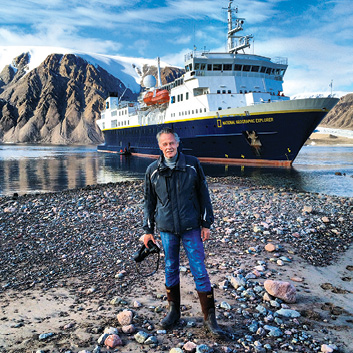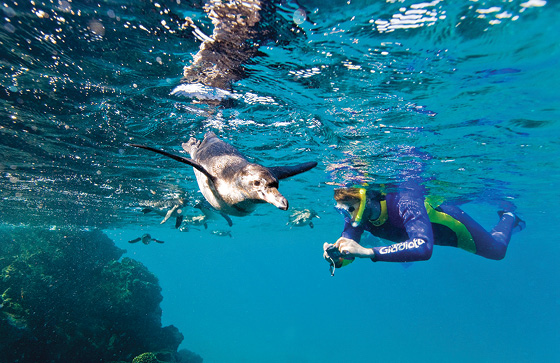- Home
- Media Kit
- Current Issue
- Past Issues
- Ad Specs-Submission
- Ad Print Settings
- Reprints (PDF)
- Photo Specifications (PDF)
- Contact Us

![]()
ONLINE


Sven Lindblad on Ellesmere Island,
Canadian Arctic, Northwest Passage, Canada
Educational Expeditions
Editors’ Note
Sven-Olof Lindblad was born in Switzerland and traveled extensively with his father, renowned adventure-travel pioneer Lars-Eric Lindblad, who led some of the first non-scientific groups of travelers to Galápagos, Antarctica, and other regions of the world. For six years, Sven lived in East Africa photographing elephants and wildlife in Kenya and assisting filmmakers on a documentary about the destruction of African rain forests. In 1979, he launched Special Expeditions (now Lindblad Expeditions; expeditions.com), an innovative travel company offering marine-focused expeditions aboard small ships. Lindblad has built his company around a core tenet: to provide travelers the opportunity to discover for themselves the natural, cultural, and historic regions of the world and to provide thoughtful approaches that make such travels enriching, responsible, safe, fun, and memorable. In 2004, Lindblad formed a multifaceted strategic alliance with National Geographic. This mission, coupled with the company’s long-standing commitment to conservation, has positioned Lindblad Expeditions at the forefront of environmentally sensitive expedition travel and resulted in numerous travel and environmental awards. In May 2006, Lindblad received international recognition for his distinctive and successful model of tourism in a ceremony hosted by HRH, Grand Duke Henri of Luxembourg at the Grand-Ducal Palace. He also has a newly discovered endemic species of moth in the Galápagos Islands, Undulambia lindbladi, named in honor of his conservation work in the archipelago. The United Nations Environment Programme also recognized Lindblad’s accomplishments, naming him to their Global 500 roll of honor. Lindblad was named commissioner of the Aspen Institute’s Commission on Arctic Climate Change in 2008, and is a founding Ocean Elder of the nonprofit organization, Ocean Elders. Lindblad’s photography has appeared in Smithsonian and National Geographic magazines, and he has produced photography books on Alaska, Baja California, and Tanzania’s Serengeti National Park, published by Rizzoli.

A Lindblad cruise guest swimming with an adult
Galápagos penguin hunting fish underwater in the
Galápagos Island Group, Ecuador (above)
Would you touch on the history and heritage of Lindblad Expeditions and how the business has evolved?
We launched Lindblad Expeditions in 1979 as a division of Lindblad Travel, which started in 1958. It operated from the beginning as an independent enterprise, although Lindblad Travel had a stake in the business. At that time, it was called Special Expeditions.
The reason we did that was because at that time, Lindblad Travel was opening up China – it was the only American organization allowed in China and was consumed by that. I wanted to have a business that could focus on more natural history-focused expeditions in Africa, India, and various parts of the world.
Then we started chartering ships so we could use ships as a base camp to more efficiently get to different, interesting places.
We acquired our first full-time ship in 1987, another in 1994, and we just kept adding ships. We also still had a vibrant land-based business.
Once 9/11 happened, we decided to jettison our land business and focus entirely on the ships because those were fixed platform obligations. We thought that would be a temporary idea but it started to make a lot of sense because it provided a specific focus.
In 1997, we put a real footprint on the Galápagos Islands. It was the first time someone outside of Ecuador had put a ship there permanently. We now have two ships there.
In 2004, we developed a strategic alliance with the National Geographic Society and we now have an agreement to work together at least until 2025.
We’re also on a path to build ships from scratch, one for delivery in 2017, one in 2018, and one in 2019.
Overall, we believe that people have an explorer gene. We believe there are a significant number of people, growing by the minute, who have an interest in getting to remote areas, and we believe that people like the idea of an educational component with expert education. We know photography is growing exponentially as well.
We take what we know, which is geography, and what we can put together in terms of human resources, crew, and staff, and pay attention to what matters to our guests in terms of their aspirations.
It’s a real partnership between us and our guests.
Is it difficult to find more remote areas to bring on as new destinations or are you just enhancing your current offerings?
The age of exploration has changed dramatically. We’re not going to these remote areas to find we’re the only ones there.
On the positive side, we’re forced to focus on the nuances.
When I first went to Antarctica in 1973 on my father’s ship, it was incredibly inspiring and rustic. But it wasn’t nearly as interesting an experience from a traveler’s point of view as they can have today. That is because we know more.
We now have much better predictability of weather, ice conditions, and sonar that can help with navigation. We have been there consistently for decades so we know how to stretch as much as we can to give people an extraordinary experience in a safe way.
We have underwater technology now – ROVs (remotely operated vehicles) that can go down 1,000 feet; we have people who dive in these places and can bring up footage and explain what is going on under the sea. We have a polar kayaking program for people to experience this incredibly wild place independently that is also safe.
Geography is shrinking but opportunities are greater now.
As you expand the on-land opportunity, will that be directed at the same client?
We’re not expanding the land business as Lindblad Expeditions, but we bought a company recently, Natural Habitat, which is very good at the land business, and will offer their programs to our guests.
Many of our guests might be on a safari in Africa one month and in Paris three months later. They are diverse in their interests.
In getting into the land business, we could have built it from scratch or found a company we respected who handled it well and where we could add value to what it was doing, so that’s what we decided to do.
How critical is the conservation piece for you?
We look through a triangular lens – one point is the guest, one point is the geography, and the third point is the business. If everything feeds positively off everything else, then we believe it’s a good idea. If any one of those points is missing, it’s a bad idea.
We’re not philanthropists, per se. We put a lot of resources into working with National Geographic and others to develop conservation strategies about things we have identified that matter in places. We raise over 1.5 million dollars per year that we put into these efforts.
We find guests appreciate it because they can give back to places that have given them so much. Our personnel are also very proud about that.
We’ve seen significant value as a consequence of our efforts and people generally like to see us coming. I think the travel industry could do a better job of investing overall in the assets we all trade upon.•